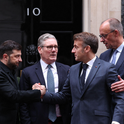The Labour manifesto was a curious document. For the most part the concrete, costed pledges were small scale and low budget—designed not to scare undecided voters. But the ambitions were vast: a huge increase in renewable energy by 2030, a return to the NHS waiting lists of the early 2010s, halving knife crime in a decade, and so on. The next year is about filling in the gap in the middle—and identifying the route to achieving these grand designs.
Over the coming months we will see a flurry of activity, following years of drift and desperate headline chasing. From every department there will be green and white papers, draft bills, consultations and reviews. New ministers will be setting out their visions and attempting to ingratiate themselves with the key groups in their sectors. With such an enormous majority, they will get a warm reception from anyone looking for access and influence. For similar reasons they’ll get a relatively easy ride from the press, for a little while at least. It’s going to feel very different to the recent Conservative era.
But the context remains exceptionally difficult. The trade-offs that the previous government chose to ignore will have to be faced. The most obvious is money. Spending plans for the next year will be set out in a budget in the autumn, which will probably be followed by a more comprehensive review in 2025. Difficult choices will be unavoidable.
For all the bluster about needing reform rather than more spending, they are not separate paths to be taken. Any plan for seriously overhauling the NHS, the justice system or local government will require a lot of money. Exactly how challenging this is will depend on OBR forecasts. It’s hard to see how the numbers can be made to add up without tax increases or changes to borrowing rules.
Continuing with the Conservative spending plans will not be an option. Rishi Sunak and Jeremy Hunt had to placate a Tory party, and media, that wanted tax cuts. Conversely, the MPs sitting behind Keir Starmer and Rachel Reeves will be lobbying for spending on their policy priorities. The new parliament contains 500 MPs from the left and centre, most of whom (according to my own research) worked for the public or third sector before entering politics. Having spent the last 14 years fulminating against austerity and its grim consequences, they are not going to want to find themselves cast as the bad guys.
Beyond spending, the political composition of the new parliamentary Labour party creates the potential for conflict over policy, outwith the usual factional wars. There are MPs in urban seats, facing the Greens and independents, who will be looking at the losses of Thangam Debbonaire (Bristol Central) and Jonathan Ashworth (Leicester South) with trepidation. Others in northern and Midlands towns will now see Reform in second place, tapping into anti--establishment frustration—particularly around high immigration. For the first time in a long while, there are Labour MPs in rural seats, many never held by the party before. It’s these MPs who will be under constant attack from Nimby Tories running campaigns against every new development, let alone any planning reforms that put the green belt under threat.
On top of the financial and political challenges of putting together a domestic agenda to meet manifesto ambitions, there will also be the inevitable stream of crises that distract and force re-prioritisation. Some of these are known: the lack of space in prisons; the impending Thames Water collapse; public pay awards that are unaffordable for schools and hospitals without additional cash; workforce shortages in social care and early years; crumbling infrastructure; the HS2 mess and so forth. Still others will appear out of nowhere.
Global instability is a potentially fertile source of such distractions. French politics—and thus EU politics—is in turmoil as Macron struggles to contain a resurgent, populist right. Trump is odds on to be back as president in November. China’s economic struggles are threatening to blow up into something more dramatic. The Middle East is still on fire, which is more politically difficult for Labour than the Tories. And, of course, the war in Ukraine continues to pose a major threat. Starmer, like most prime ministers, wants to focus on the domestic issues that matter most to voters. Like all his predecessors, however, he will end up spending a large amount of time on foreign policy.
Creating the necessary space to tackle Britain’s problems is going to require not just greater focus and competence than the last government was able to muster, but a different approach to running the state. Alongside all the departmental policy activity, Starmer and his team need to think about the underpinning machinery of state. Can they devolve more operational activity away from Whitehall and free up central capacity? Can this be the first government to truly commit to civil service reform? How does Labour manage the modern media cycle without getting sucked into a cycle of endless cosmetic, but time-consuming, announcements?
Keeping their head above water long enough to think about these meta policy questions will, ultimately, define what Starmer’s government is able to deliver by 2029. All the good intentions in the world will not keep a plane flying if the engine has failed.













